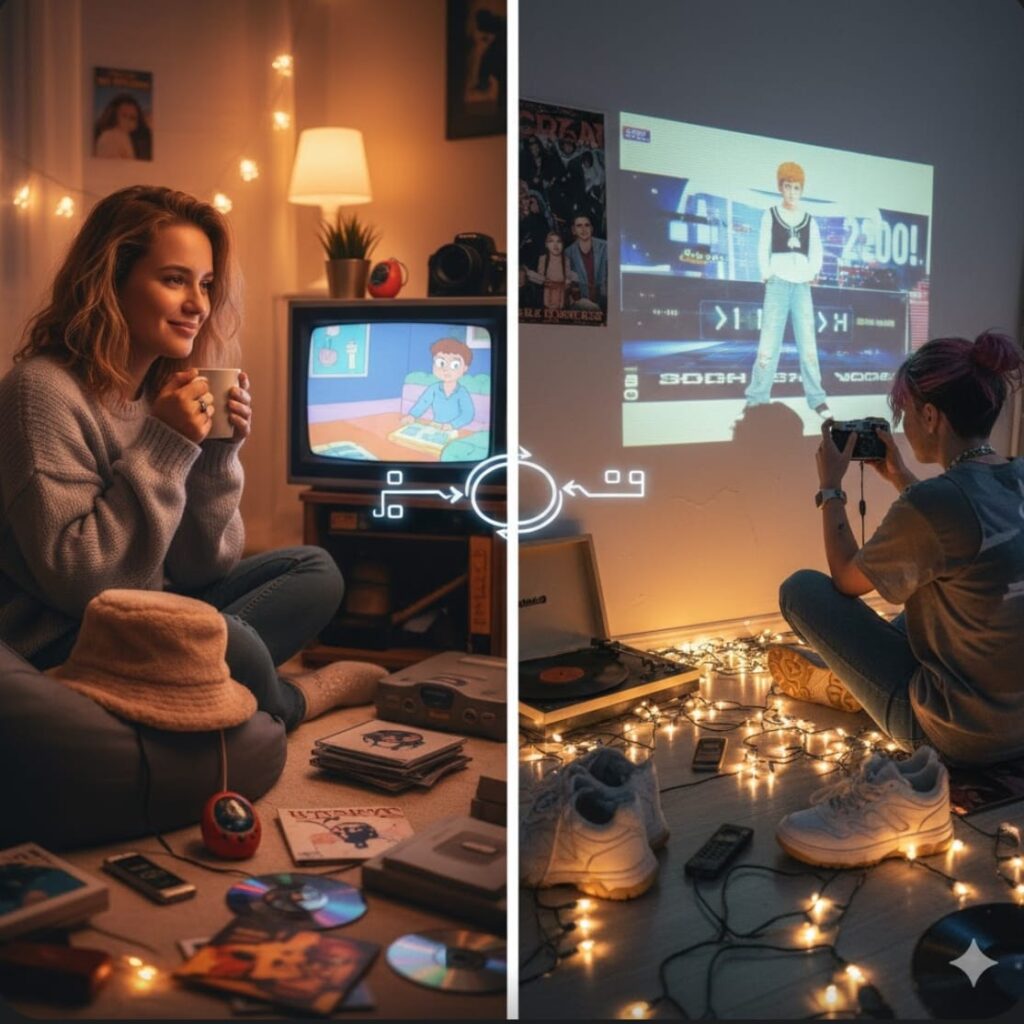Why Both Millennials and Gen Z Are Obsessed With Nostalgia

Nostalgia is more than a wistful memory of the past; it’s a comforting blanket, a psychological oasis in a world that seems increasingly chaotic, unpredictable, and digital. Ask any Millennial about their favorite Saturday mornings, and they’ll probably wax poetic about cartoons, VHS tapes, and cereal boxes that promised sugar-fueled adventures. Ask a Gen Zer, and they may talk about scrolling through memes that reference early 2000s pop culture, retro video games, or even rewinding “old” TikTok sounds that feel vintage to them. Despite being different generations with different experiences, Millennials and Gen Z share a deep fascination with nostalgia. But why has longing for “the good old days” become such a cultural obsession? And why do these two generations, often assumed to be divided by technology and values, find themselves emotionally tethered to the past?
For Millennials, nostalgia is often tied to a very tangible childhood. Theirs was a world that straddled analog and digital, a liminal space where Saturday morning cartoons were sacred, and a trip to Blockbuster could feel like a pilgrimage. They grew up with physical toys, physical media, and the kind of slow-paced entertainment that allowed the imagination to flourish. There was a tactile satisfaction in blowing into a Nintendo cartridge to make it work, or waiting a full minute for dial-up internet to connect. Even music had texture—CDs had to be unwrapped, mixtapes required careful curation, and the act of recording a song off the radio was a small ritual in patience. This tangible connection to their past creates a sense of longing today. When Millennials scroll through memes about “90s kids” or binge watch shows like Friends or The Office, they are reconnecting with a world that felt safer, slower, and simpler. Nostalgia serves as a psychological anchor in adulthood, a reminder of a time when life was less complicated, bills were fewer, and choices felt infinite.
Gen Z, despite growing up fully immersed in the digital era, is perhaps even more obsessed with nostalgia—though in a slightly different way. For them, nostalgia isn’t necessarily about their early childhood. Instead, it is about reclaiming the recent past, the pop culture of the late 1990s and early 2000s, or even trends from early social media that now feel quaint. The same YouTube videos, Polaroid filters, and retro fashion statements that Millennials once experienced firsthand are now consumed by Gen Z as a kind of curated, aestheticized memory. They interact with these nostalgic elements through TikTok, Instagram Reels, and viral trends that romanticize a time they may not have even lived through. For Gen Z, nostalgia is not only comforting—it is performative, a way to engage with culture, community, and identity in a hyper-connected digital world. Vintage sneakers, Game Boys, floppy disks, and VHS aesthetics are consumed, remixed, and shared, creating a communal sense of longing that transcends actual experience.
One reason both generations are obsessed with nostalgia is the speed of change in the world. Technology evolves rapidly, cultural trends shift overnight, and the pace of life seems relentlessly accelerated. Millennials watched the rise of social media, smartphones, and streaming, often feeling like their childhood was slipping away before their eyes. Gen Z has never known life without these technologies, yet they witness the constant evolution of platforms, memes, and influencers, making even recent trends feel outdated almost immediately. Nostalgia provides stability in this ever-shifting landscape. It is a pause button, a way to step back into a moment where things felt simpler, more tangible, and more controllable.
Moreover, nostalgia is deeply intertwined with identity formation. For Millennials, the objects, media, and experiences of childhood are markers of who they were and, by extension, who they are now. Watching reruns of cartoons, listening to songs from their teenage years, or playing video games from their youth is an act of reaffirming identity. It is both comforting and validating, a reminder that despite the messiness of adult life, a version of themselves still exists, intact, somewhere in memory. For Gen Z, nostalgia functions similarly, but with a communal twist. Sharing old memes, viral videos, or retro fashion trends creates bonds between peers, generating a sense of belonging through collective longing. In a generation that has grown up digitally, where social validation often comes in likes, shares, and comments, nostalgia becomes a social adhesive, a way to connect over a shared understanding of “the past,” whether experienced directly or vicariously.
The commercialization of nostalgia has only intensified its appeal. Brands and media companies have recognized that Millennials and Gen Z will spend money to relive the past. Reboots of classic shows, retro merchandise, and vintage-inspired clothing lines flood the market, catering directly to this emotional longing. Millennials happily purchase Pokémon cards or 90s-inspired apparel, while Gen Z eagerly snaps up platform sneakers or retro-style gadgets that never existed in their own childhoods. Even social media thrives on nostalgia. Hashtags like #ThrowbackThursday, #90sKid, or #RetroAesthetic garner millions of engagements, as users share photos, videos, and memories that evoke a shared longing for simpler times. This commercialization does more than just sell products—it validates the emotional pull of nostalgia, making it culturally acceptable, fun, and even trendy to engage with the past.
Interestingly, the nostalgia of Millennials and Gen Z often overlaps and merges. Millennial nostalgia for physical, tactile experiences intersects with Gen Z’s digital re-imagination of those same experiences. A vinyl record or Game Boy cartridge may have been a Millennial staple, but Gen Z experiences it as aesthetic content, remixed, shared, and curated online. Cartoons, fashion trends, and music from the 90s and early 2000s have become generational bridges, allowing both Millennials and Gen Z to interact through a shared emotional lens. Nostalgia, in this sense, becomes both a personal comfort and a cultural dialogue, connecting generations despite differences in upbringing and technology.
Another layer to this obsession is emotional coping. Both generations face unique pressures and anxieties that were less prevalent for prior generations. Millennials struggle with job insecurity, student debt, and a shifting social contract. Gen Z navigates climate anxiety, global political turmoil, and the paradox of hyperconnectivity, where they are constantly plugged into news, social media, and peer networks. Nostalgia functions as an emotional balm, providing moments of reprieve from stress. Revisiting old cartoons, viral videos, or childhood games creates psychological comfort—a reminder that there was a time when life felt simpler, decisions were less consequential, and joy was easier to find. In this sense, nostalgia is not just an indulgence; it is a necessary tool for mental and emotional survival.
Ironically, nostalgia is also inherently performative in the digital era. Both Millennials and Gen Z consume nostalgia in ways that are meant to be seen and shared. Instagram grids filled with retro aesthetics, TikTok videos that remix 90s songs, and memes that reference old school cartoons are not just private indulgences—they are public declarations of identity, taste, and cultural literacy. Sharing nostalgia signals belonging, awareness, and cultural competence. For Millennials, it may be about showcasing childhood experiences authentically. For Gen Z, it may be about engaging with an aesthetic and digital community that collectively celebrates the past. In both cases, nostalgia reinforces social connection and identity formation, further explaining why it has become such a central obsession.
Ultimately, the fascination with nostalgia reveals something fundamental about human psychology. Both Millennials and Gen Z are searching for continuity in lives marked by rapid change. They are seeking comfort, identity, and connection in a world that constantly demands adaptation. Nostalgia allows them to travel back to moments that feel safer, happier, or more meaningful—even if those moments are idealized reconstructions. It is an emotional anchor, a bridge between personal memory and cultural heritage, a tool for coping with the complexities of modern life.
In the end, the shared obsession with nostalgia demonstrates a surprising similarity between Millennials and Gen Z. Despite differences in upbringing, technology, and cultural context, both generations turn to the past to navigate the present. They consume, remix, share, and celebrate nostalgia in ways that are emotionally fulfilling, socially connecting, and even commercially influential. Whether it’s a Millennial rewatching Friends for the hundredth time or a Gen Zer styling platform sneakers with a vintage Game Boy, nostalgia serves as a bridge—a reminder that no matter how fast the world moves, the past remains a comforting, inspiring, and endlessly fascinating part of human experience.
In a society obsessed with the “next big thing,” it is telling that both generations find solace, humor, and identity in the past. Nostalgia is not just about longing—it is about connection, creativity, and survival. It is proof that, even in a hyper-digital, constantly evolving world, humans crave roots, familiarity, and emotional continuity. Millennials and Gen Z may experience the past differently, but they are united in their need to revisit it, celebrate it, and share it. Nostalgia, in this sense, is both timeless and timely, a generational obsession that tells us as much about the present as it does about the past.



